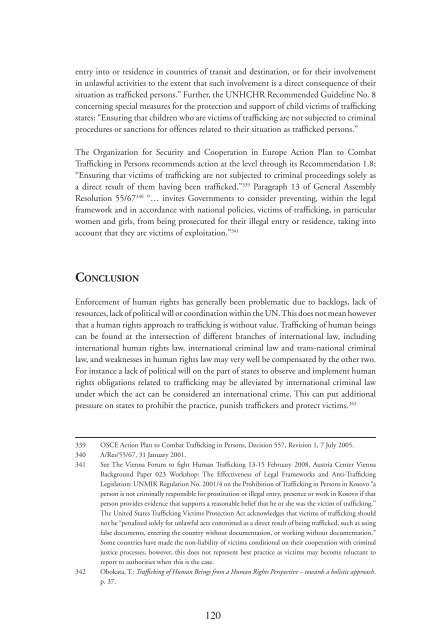Trafficking in human beings: human rights and ... - unesdoc - Unesco
Trafficking in human beings: human rights and ... - unesdoc - Unesco
Trafficking in human beings: human rights and ... - unesdoc - Unesco
You also want an ePaper? Increase the reach of your titles
YUMPU automatically turns print PDFs into web optimized ePapers that Google loves.
entry <strong>in</strong>to or residence <strong>in</strong> countries of transit <strong>and</strong> dest<strong>in</strong>ation, or for their <strong>in</strong>volvement<br />
<strong>in</strong> unlawful activities to the extent that such <strong>in</strong>volvement is a direct consequence of their<br />
situation as traffi cked persons.” Further, the UNHCHR Recommended Guidel<strong>in</strong>e No. 8<br />
concern<strong>in</strong>g special measures for the protection <strong>and</strong> support of child victims of traffi ck<strong>in</strong>g<br />
states: “Ensur<strong>in</strong>g that children who are victims of traffi ck<strong>in</strong>g are not subjected to crim<strong>in</strong>al<br />
procedures or sanctions for offences related to their situation as traffi cked persons.”<br />
The Organization for Security <strong>and</strong> Cooperation <strong>in</strong> Europe Action Plan to Combat<br />
Traffi ck<strong>in</strong>g <strong>in</strong> Persons recommends action at the level through its Recommendation 1.8;<br />
“Ensur<strong>in</strong>g that victims of traffi ck<strong>in</strong>g are not subjected to crim<strong>in</strong>al proceed<strong>in</strong>gs solely as<br />
a direct result of them hav<strong>in</strong>g been traffi cked.” 339 Paragraph 13 of General Assembly<br />
Resolution 55/67 340 “… <strong>in</strong>vites Governments to consider prevent<strong>in</strong>g, with<strong>in</strong> the legal<br />
framework <strong>and</strong> <strong>in</strong> accordance with national policies, victims of traffi ck<strong>in</strong>g, <strong>in</strong> particular<br />
women <strong>and</strong> girls, from be<strong>in</strong>g prosecuted for their illegal entry or residence, tak<strong>in</strong>g <strong>in</strong>to<br />
account that they are victims of exploitation.” 341<br />
CONCLUSION<br />
Enforcement of <strong>human</strong> <strong>rights</strong> has generally been problematic due to backlogs, lack of<br />
resources, lack of political will or coord<strong>in</strong>ation with<strong>in</strong> the UN. This does not mean however<br />
that a <strong>human</strong> <strong>rights</strong> approach to traffi ck<strong>in</strong>g is without value. Traffi ck<strong>in</strong>g of <strong>human</strong> be<strong>in</strong>gs<br />
can be found at the <strong>in</strong>tersection of different branches of <strong>in</strong>ternational law, <strong>in</strong>clud<strong>in</strong>g<br />
<strong>in</strong>ternational <strong>human</strong> <strong>rights</strong> law, <strong>in</strong>ternational crim<strong>in</strong>al law <strong>and</strong> trans-national crim<strong>in</strong>al<br />
law, <strong>and</strong> weaknesses <strong>in</strong> <strong>human</strong> <strong>rights</strong> law may very well be compensated by the other two.<br />
For <strong>in</strong>stance a lack of political will on the part of states to observe <strong>and</strong> implement <strong>human</strong><br />
<strong>rights</strong> obligations related to traffi ck<strong>in</strong>g may be alleviated by <strong>in</strong>ternational crim<strong>in</strong>al law<br />
under which the act can be considered an <strong>in</strong>ternational crime. This can put additional<br />
pressure on states to prohibit the practice, punish traffi ckers <strong>and</strong> protect victims. 342<br />
339 OSCE Action Plan to Combat Traffi ck<strong>in</strong>g <strong>in</strong> Persons, Decision 557, Revision 1, 7 July 2005.<br />
340 A/Res/55/67, 31 January 2001.<br />
341 See The Vienna Forum to fi ght Human Traffi ck<strong>in</strong>g 13-15 February 2008, Austria Center Vienna<br />
Background Paper 023 Workshop: The Effectiveness of Legal Frameworks <strong>and</strong> Anti-Traffi ck<strong>in</strong>g<br />
Legislation: UNMIK Regulation No. 2001/4 on the Prohibition of Traffi ck<strong>in</strong>g <strong>in</strong> Persons <strong>in</strong> Kosovo “a<br />
person is not crim<strong>in</strong>ally responsible for prostitution or illegal entry, presence or work <strong>in</strong> Kosovo if that<br />
person provides evidence that supports a reasonable belief that he or she was the victim of traffi ck<strong>in</strong>g.”<br />
The United States Traffi ck<strong>in</strong>g Victims Protection Act acknowledges that victims of traffi ck<strong>in</strong>g should<br />
not be “penalized solely for unlawful acts committed as a direct result of be<strong>in</strong>g traffi cked, such as us<strong>in</strong>g<br />
false documents, enter<strong>in</strong>g the country without documentation, or work<strong>in</strong>g without documentation.”<br />
Some countries have made the non-liability of victims conditional on their cooperation with crim<strong>in</strong>al<br />
justice processes, however, this does not represent best practice as victims may become reluctant to<br />
report to authorities when this is the case.<br />
342 Obokata, T.: Traffi ck<strong>in</strong>g of Human Be<strong>in</strong>gs from a Human Rights Perspective – towards a holistic approach.<br />
p. 37.<br />
120

















